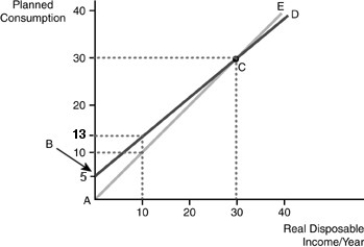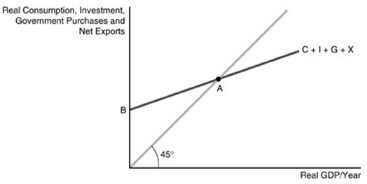A) include goods such as CDs that a music store holds in inventory.
B) are only the goods bought by households for immediate satisfaction.
C) include spending on machines and buildings so that goods can be produced in the future.
D) are goods that are used to make other goods.
Correct Answer

verified
Correct Answer
verified
Multiple Choice
 -Refer to the above table. The table gives the combinations of real disposable income and real consumption for a college student for a year. The break-even level of real disposable income is
-Refer to the above table. The table gives the combinations of real disposable income and real consumption for a college student for a year. The break-even level of real disposable income is
A) 0.
B) 6000.
C) 1000.
D) 1400.
Correct Answer

verified
Correct Answer
verified
Multiple Choice
Average propensity to consume
A) is the same as the break-even point.
B) gives the amount a person changes planned consumption for a change in real disposable income.
C) is the amount of consumption that is independent of the level of disposable income.
D) is the proportion of total disposable income that is consumed.
Correct Answer

verified
Correct Answer
verified
Multiple Choice
Suppose when real disposable income is $5000, planned real consumption is $4000. When real disposable income increases to $6000, planned real saving increases by $500. The new planned real consumption expenditures is
A) $5,000.
B) $4,500.
C) $6,000.
D) $3,500.
Correct Answer

verified
Correct Answer
verified
Multiple Choice
Suppose that when disposable income increases by $2,000, consumption spending increases by $1,500. Given this information, we know that the marginal propensity to consume (MPC) is
A) 0.25.
B) 0.75.
C) 1.33.
D) 4.
Correct Answer

verified
Correct Answer
verified
Multiple Choice
 -Refer to the above figure. If real disposable income is $30,000, saving is
-Refer to the above figure. If real disposable income is $30,000, saving is
A) $0.
B) $4000.
C) $5000.
D) $6000.
Correct Answer

verified
Correct Answer
verified
Multiple Choice
Autonomous consumption is defined as
A) the level of real consumption spending that is independent of real disposable income.
B) the real consumption spending by the autonomous government.
C) the level of real consumption spending that is equal to real disposable income.
D) the consumption of foreign-made goods independent of exchange rates.
Correct Answer

verified
Correct Answer
verified
Multiple Choice
Autonomous consumption is the level of consumption that is
A) consistent with the average standard of living.
B) observed at the poverty line.
C) independent of real income.
D) available to someone earning the minimum wage.
Correct Answer

verified
Correct Answer
verified
Multiple Choice
The marginal propensity to save (MPS) is
A) the rate at which real savings changes over time.
B) the percentage of real disposable income saved.
C) the difference between the amounts of real disposable income consumed and saved.
D) the percentage of an additional dollar of real disposable income that will go toward additional real savings.
Correct Answer

verified
Correct Answer
verified
Multiple Choice
The difference between a stock and a flow is
A) a stock is something measured at one point in time while a flow is something that is expressed per unit of time.
B) a stock is something measured at one point in time while a flow is something that is fixed.
C) a stock is expressed per unit of time while a flow is measured at one point in time.
D) a stock refers to the solid inventory firms have on hand while a flow refers to the liquid inventory firms have on hand.
Correct Answer

verified
Correct Answer
verified
Multiple Choice
Consumption goods are
A) a form of investment.
B) goods purchased from savings.
C) a form of capital goods.
D) goods purchased by households for immediate use.
Correct Answer

verified
Correct Answer
verified
Multiple Choice
 -Refer to the above figure. Point B
-Refer to the above figure. Point B
A) equals autonomous consumption.
B) equals autonomous consumption plus planned investment plus autonomous government spending plus autonomous net exports.
C) has no special significance.
D) equals government expenditures.
Correct Answer

verified
Correct Answer
verified
Multiple Choice
In the Keynesian model, whenever planned investment is greater than planned saving
A) the amount of planned investment will decrease, and real GDP will decrease.
B) the amount of planned investment will decrease, and real GDP will remain unchanged.
C) there will be an unplanned inventory decrease, and GDP will eventually increase.
D) there will be an unplanned inventory increase, and GDP will eventually decrease.
Correct Answer

verified
Correct Answer
verified
Multiple Choice
Investment is
A) the purchasing of stocks and mutual funds.
B) spending by consumers on items that account for large shares of their budgets.
C) spending by businesses on things which can be used to produce goods and services in the future.
D) the production of goods for immediate satisfaction.
Correct Answer

verified
Correct Answer
verified
Multiple Choice
In the Keynesian model, a decrease in real autonomous spending results in a more than proportional decrease in real Gross Domestic Product (GDP) because
A) consumption decreases as a result of lower real disposable income.
B) consumption increases while real disposable income decreases.
C) real autonomous spending decreases further as real disposable income decreases.
D) government spending also decreases.
Correct Answer

verified
Correct Answer
verified
Multiple Choice
According to Keynes, the primary determinant of a person's saving is NOT
A) the person's level of income but the desired real income of the person.
B) the person's level of savings but the expected interest rate in the near future.
C) the interest rate but the level of savings the person has.
D) the interest rate but the level of the person's real disposable income.
Correct Answer

verified
Correct Answer
verified
Multiple Choice
If your real disposable income goes up by $200 per week, and your real consumption spending goes up by $160 per week, you have an marginal propensity to save of
A) 0.2.
B) 0.8.
C) 1.2.
D) 1.0.
Correct Answer

verified
Correct Answer
verified
Multiple Choice
The part of consumption that does NOT depend upon the level of disposable income is
A) autonomous consumption.
B) saving.
C) savings.
D) average propensity to consume.
Correct Answer

verified
Correct Answer
verified
Multiple Choice
According to Keynes, real saving and real consumption spending are functions of
A) economic expectations.
B) an individual's future earning potential.
C) current educational attainment.
D) current real disposable income.
Correct Answer

verified
Correct Answer
verified
Multiple Choice
Autonomous consumption
A) is the same as the break-even point.
B) gives the amount a person changes planned consumption for a change in real disposable income.
C) is the amount of consumption that does not depend on the level of disposable income.
D) is the amount total disposable income less planned consumption.
Correct Answer

verified
Correct Answer
verified
Showing 181 - 200 of 452
Related Exams